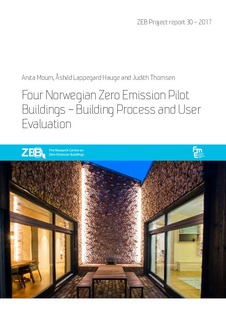| dc.contributor.author | Moum, Anita | |
| dc.contributor.author | Hauge, Åshild Lappegard | |
| dc.contributor.author | Thomsen, Judith | |
| dc.date.accessioned | 2017-11-24T06:49:46Z | |
| dc.date.available | 2017-11-24T06:49:46Z | |
| dc.date.created | 2017-11-23T14:18:15Z | |
| dc.date.issued | 2017 | |
| dc.identifier.isbn | 978-82-536-1549-3 | |
| dc.identifier.issn | 1893-1561 | |
| dc.identifier.issn | 1893-157X | |
| dc.identifier.uri | http://hdl.handle.net/11250/2467913 | |
| dc.description.abstract | About ZEB
The Research Centre on Zero Emission Buildings (ZEB), Norway (www.zeb.no), funds the research work presented in this report. ZEB is a national centre dedicated to research, innovation, and implementation within the field of energy efficient zero emission buildings. The Research Council of Norway assigned The Faculty of Architecture and Fine Art at NTNU to host one of eight new national centers for Environment‐friendly Energy Research (FME). The duration of ZEB is from 2008‐2016. The main objective of ZEB is to develop competitive products and solutions for existing and new buildings that will promote market penetration of buildings with zero greenhouse gas emissions in connection with their production, operation, and demolition. The Centre’s research encompasses residential, commercial, and public buildings.
ZEB focuses on five areas that interact and influence each other:
1: Advanced materials technologies
2: Climate‐adapted, low‐energy envelope technologies
3: Energy supply systems and services
4: Use, operation, and implementation
5: Concepts and strategies
This report is a part of area 4: Use, operation, and implementation.
Objective
The objectives are to 1) identify and analyze characteristics of processes leading towards zero emission buildings through studying experiences, drivers and barriers encountered in pilot projects, 2) identify and analyze aspects influencing use of zero emission buildings; and 3) make recommendations on how to plan a successful process towards a zero emission building project with high quality.
Method
The results are based on qualitative interviews in 4 case studies of zero emission pilot buildings. The building process and early use phase (where relevant) of each pilot building is studied through individual or group interviews of 5-8 persons per case study. The persons interviewed were clients, building owners, architects, consultants or contractors.
Findings and recommendations
Characteristics of successful processes leading towards zero emission pilot buildings are:
• To regard the way from high ambitions into good buildings as a development project of its own,
requiring careful planning, management and follow-up.
• To formulate clear goals, connected to an understanding of purpose and legitimacy. The clients, the executing parties and the building owners and users must be committed to the goals.
• To motivate all parties for "mastering the unknown".
• To focus strongly on collaboration and involvement, in procurement forms and contracts, through
management style and trough the establishment of good meeting arenas. It is important to involve
production actors1 early in the development process. | |
| dc.description.sponsorship | This report has been written within the Research Centre on Zero Emission Buildings (ZEB). The authors gratefully acknowledge the support from the Research Council of Norway, BNL – Federation of construction industries, Brødrene Dahl, ByBo, DiBK – Norwegian Building Authority, Caverion Norge AS, DuPont, Entra, Forsvarsbygg, Glava, Husbanken, Isola, Multiconsult, NorDan, Norsk Teknologi, Protan, SAPA Building Systems, Skanska, Snøhetta, Statsbygg, Sør-Trøndelag Fylkeskommune, and Weber. We also want to thank the persons we have interviewed in the pilot projects, for their willingness to share their experiences and stories with us. Finally, we are grateful for the comments by Professor Thomas Berker, NTNU. | |
| dc.language.iso | nob | |
| dc.publisher | SINTEF akademisk forlag | |
| dc.relation.ispartofseries | ZEB Project report;30 | |
| dc.subject | Building evaluation | |
| dc.subject | Construction process | |
| dc.subject | Innovation | |
| dc.title | Four Norwegian Zero Emission Pilot Buildings – Building Process and User Evaluation | |
| dc.type | Research report | |
| dc.description.version | publishedVersion | |
| dc.rights.holder | © 2017 SINTEF Academic Press and Norwegian University of Science and Technology | |
| dc.subject.nsi | VDP::Technology: 500 | |
| dc.source.pagenumber | 80 | |
| dc.source.issue | 30 | |
| dc.identifier.cristin | 1517738 | |
| cristin.unitcode | 7401,30,20,0 | |
| cristin.unitname | Bygninger og installasjoner | |
| cristin.ispublished | true | |
| cristin.fulltext | original | |
